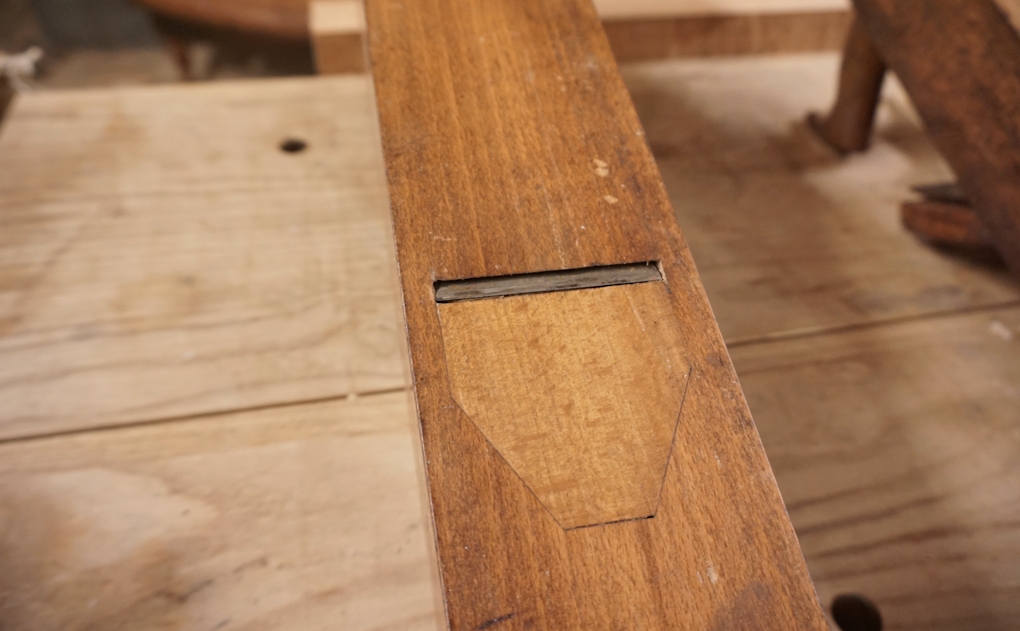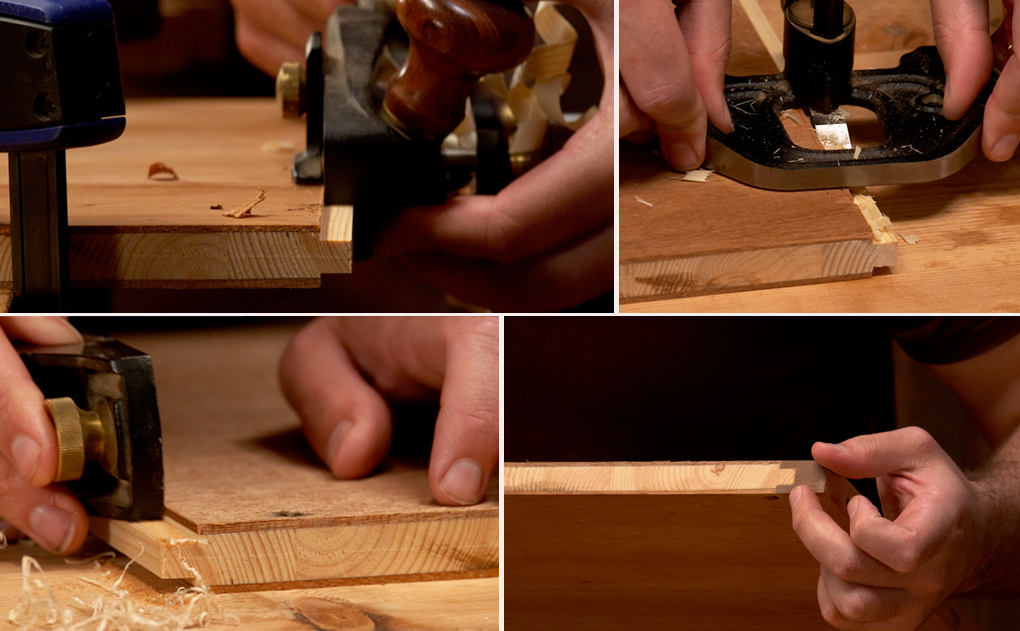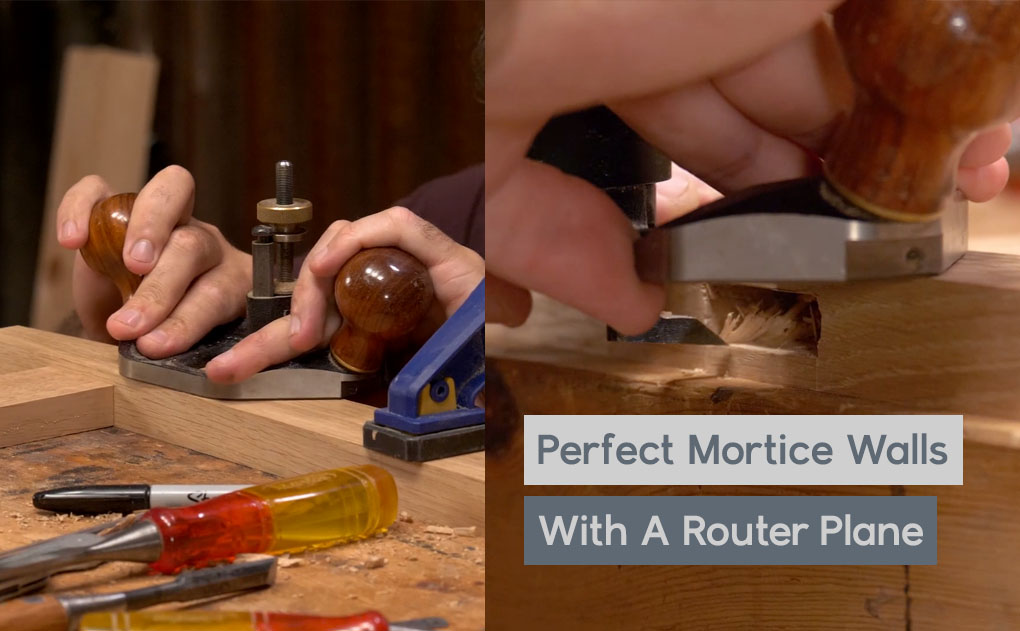How wide is too wide when it comes to mouths on wooden planes? When looking out for a used one this could be one of your key areas of concern, but that worry might only be justified towards the finer end of the spectrum, and even then it’s a quick and easy fix.
A cap iron can control your tear out regardless of mouth width, as we covered in our videos here, but a huge gapping mouth on a smoothing plane is still not ideal.
A wide mouth on a single iron smoother would prevent the tool working for it’s intended purpose, whilst at the opposite end it’s going to be essential on a scrub plane or very coarse jack, to allow the thick shavings to escape freely.
But what do you do with something in the middle; a long plane which you want to take a medium cut, such as a jointer?
Should you patch up a wide mouth or leave it be?
This is a question we were asked by Ian on Helen’s post on the wooden jointer plane, and I’d thought I’d cover a few thoughts.
Ian’s jointer has a fat 3/16″ of space in front of the cutting edge – should the mouth be closed up? Well that is bloody wide.
If it was my tool though I’d do the minimum essential work to put it to use and get to know it first. The wide mouth is unlikely to be the culprit for a poorly working jointer, my priority would be to straighten the sole and ensure that the iron is sitting flat and registered well to the bed. Hollow spots on the bed won’t matter but any high spots that cause the iron to rock will cause the plane to do stunts, particularly when put under load in hardwoods. You also need a well fitted wedge.
A tight mouth isn’t always essential to the work of a jointer plane, particularly if you have a cap iron, so if you’re happy with your results you could leave it be.
But fixing it isn’t a big job either, and if you don’t want to worry about faffing with your cap iron, or you’d like to take some pride in the tool, then it’s not time wasted to fix it. Once you have a jointer that you know and trust, you’ll find yourself using it a lot more than you might expect, they really are lovely tools, particularly the heavy ones.
 My preferred approach for closing up a mouth would be the infill in to the sole as shown in the photo, rather than packing between the bed and iron. This jointer was altered long before I got my hands on it and has been given a very nice tight mouth, too tight for coarse work.
My preferred approach for closing up a mouth would be the infill in to the sole as shown in the photo, rather than packing between the bed and iron. This jointer was altered long before I got my hands on it and has been given a very nice tight mouth, too tight for coarse work.
The row of mouth openings in the photo below show what I get by with, with a handful of current users.
Left to right: Dog of a Jack plane (this hand plane’s extremely worn but is still my favourite for rough hogging), Double iron Jointer, Double iron Smoother, Single iron Smoother (notice how tight the mouth is in front of the iron).


![Which Saws Are Best For Ripping Thick Stuff? [Video]](https://www.theenglishwoodworker.com/wp-content/uploads/2022/12/what-hand-saw-is-best-for-thick-rip-cuts.jpg)

![Quick Homemade Clamps – Small & Large [with video]](https://www.theenglishwoodworker.com/wp-content/uploads/2022/08/how-to-make-your-own-woodworking-clamps.jpg)

Many thanks for your comprehensive reply Richard. You have answered all the questions I had in my mind, and I will live with it as it is for a while to see how I like it. Yes, my new (to me) long plane seems to work very well with it’s mouth wide open, although so far I’ve only used it on softwood. The wedge is a nice progressively tightening fit. I did flatten the sole a little using my lovely infill plane which takes whisper fine shavings, but stopped before I took too much away so as not to make the wide mouth even wider.
The graving piece fitted to tighten the mouth might be a project for the future, once I’ve fallen in love with the plane.
Hi Ian,
It’s a good attitude to not give a tool anything more than it needs until it’s earnt it’s keep! Best of luck with your new plane.
Who made that single iron smoother?? That can’t be vintage.
You’re right Joe, it certainly aint vintage, it’s from Phil Edwards. It’s a very lovely tool!
For the past ten years I have been trying to put together a collection of wood planes made by H. E. Mitchell, a relative of mine, who operated in Eastbourne, then Brighton, from 1867 to 1900. I haven’t got far with this as examples of his work are as rare as hen’s teeth, but I do have one of his smoothers. One of its previous owners sunk a 1/4″ brass plate into its sole to close the mouth. It looks a little strange, but the plane does work well with it.
Hi Mitchell,
I daren’t start a collection of a particular maker, it could be a slippery slope! But having a relative to collect, that’s exciting. The brass is an interesting idea and of course minimising wear would have probably been the reason.
I know that double-iron smoother! The single iron must surely be a Philly?
I’ve seen the brass insert commonly used of old, I suspect a quick fix (I guess it runs full-width?), easier than the shaped hardwood on Richard’s example. Personally I find the wood insert (box maybe for choice?) is quite a theraputic pastime (if we need one). Can start with zero clearance and open as required before final fitting. I don’t mean I chase tight mouths (shall I re-phrase?) – just a bit of fun on a wet afternoon.
Bloody hell Doug, you haven’t hit that age have you, where you’re looking for pastimes? 😉
You’re bang on, it’s a Philly plane, it’s one of those tools that you sometimes just need to hold.
I’m often told I have a big mouth. Always sets me on edge.
Anyway, I’m using a woodie smoother that has the entire sole “boxed” in polished, burnished and waxed Ipe. It’s the hardest stuff going and the plane just glides over even the nastiest curly grain. Even curly hard maple and African mahoghany is no strain with a close set cap iron and a 1/8th inch mouth.
I made a Kernov version as a Jack, 10″, with a cherry body, Ipe sole and wedge, silicon bronze cross pin and 2″ Hock blade and cap. It’s a wonder.
Then my son made a scrub, a 8.5″ Krenov style, with a cherry body, Ipe sole and wedge, silicon bronze cross pin and 2″ Hock blade and cap. We may sell our jointer/planer it’s so fast and easy.
So finally I get to the point:
So I looked at an old wooden Jointer, about 22″ long, with a worn sole and wide mouth. It was on it’s last legs and hard to keep going. I laminated on a Ipe sole, full size. Getting the new (narrow) mouth coplanar with the bed was a bit fiddly and fussy, but once that was done, the old thing came alive again. It’s one of the best planes in the shop now.
All this talk has me returning to a project I started about 5 years ago when I built two Krenov-type planes. I laminated a bubinga sole onto a cherry body about 26″ long. I set it aside wondering about the wisdom of completing the plane. You have me about convinced that I need to do it. Now I guess I need to decide on a bedding angle and get on with it.
Hi Richard, I’m new to wood working. I make cigarbox guitars but would like to have a go at practicing some tenons and dove tails with a view to making some rudimentary furniture. Can you advise what chisels I should start with. These would have to last a while as I am on a tight budget.
Thanks, Steve.
Hoping I cause no offence to Richard by jumping in here. I would strongly suggest that you need bevel edge chisels of good quality, and the cheapest source is:
1: Aldi – their chisels come very well recommended by Paul Sellers (see his website or blog).
2: Old tools from your favourite auction site. Avoid any with plastic handles, or by unknown makers. Avoid anything that looks modern.
Bevel edge are a must for dovetails (except for those already skilled), and mortice chisels are not necessary for morticing. Again, see Paul Sellers’ blog and videos on Youtube.
I’d like to add a note to this. I’ve got the Aldi chisels, and they are indeed great for $6.99 a set.
But, they’re only available twice a year, and only just this past month or so were they sold in the US. I don’t know where the questioner came from, but if he’s here in the US he’ll have to wait at least another 4 months to see another set for sale, and he is going to have to watch for them like a hawk. The last run lasted only 4 total days in stores nationwide. That, and – they are metric widths. They are CLOSE to 1/4, 1/2, 3/4, 1″, but not quite. That may or may not matter for the questioner but it is something to think about if, say, one expects a 1″ chisel to match a 1″ slot. If the width is only a matter of preference, however, those chisels really are mighty nice with ash handles and metal-ringed tops to contain mushrooming from a mallet.
Also, to add to what Ian said, garage and estate sales (and boot sales in the UK/elsewhere), are fantastic sources of genuine old tools at genuine garage sale prices. You’ve got to do a little hunting which is honestly part of the fun. You’ll learn which neighborhoods craftsmen settled in en masse and what kinds of work they did from perusing estate sale listings, and you’ll learn just how little value their grandchildren place on their tools. I got a pair of wooden-handled English 1″ firmer chisels for $.50 each, and they’ve got at least a full 6″ of useful life left. All I’ve got to do is clean them up and sharpen them.
Richard,
You seem to reject spacing behind the blade in order to reduce the mouth.
I have used 3 and 2mm perspex spcers to bring two 40 inch jointers back to fine and medium shaving. Both my planes have two piece bladel assembly and so the spacer was made to go round the bolt holding them together. There is still sufficient wedge depth to give good clamping.
Have I missed some dangerous thing in this?
Colin Farrier in Northern Ireland